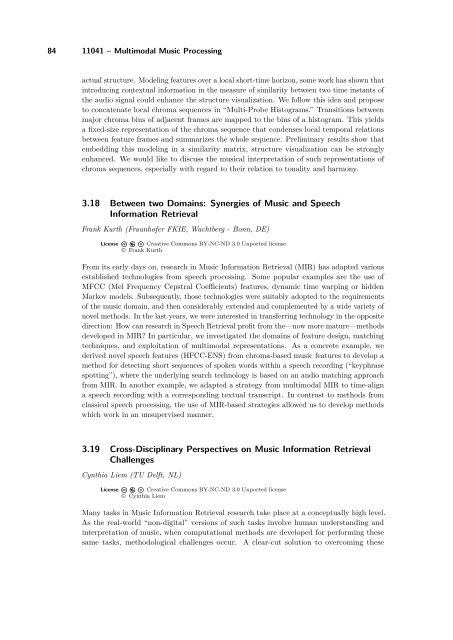Volume 1, Issue 1, January 2011 - DROPS - Schloss Dagstuhl
Volume 1, Issue 1, January 2011 - DROPS - Schloss Dagstuhl
Volume 1, Issue 1, January 2011 - DROPS - Schloss Dagstuhl
You also want an ePaper? Increase the reach of your titles
YUMPU automatically turns print PDFs into web optimized ePapers that Google loves.
84 11041 – Multimodal Music Processing<br />
actual structure. Modeling features over a local short-time horizon, some work has shown that<br />
introducing contextual information in the measure of similarity between two time instants of<br />
the audio signal could enhance the structure visualization. We follow this idea and propose<br />
to concatenate local chroma sequences in “Multi-Probe Histograms.” Transitions between<br />
major chroma bins of adjacent frames are mapped to the bins of a histogram. This yields<br />
a fixed-size representation of the chroma sequence that condenses local temporal relations<br />
between feature frames and summarizes the whole sequence. Preliminary results show that<br />
embedding this modeling in a similarity matrix, structure visualization can be strongly<br />
enhanced. We would like to discuss the musical interpretation of such representations of<br />
chroma sequences, especially with regard to their relation to tonality and harmony.<br />
3.18 Between two Domains: Synergies of Music and Speech<br />
Information Retrieval<br />
Frank Kurth (Fraunhofer FKIE, Wachtberg - Bonn, DE)<br />
License Creative Commons BY-NC-ND 3.0 Unported license<br />
© Frank Kurth<br />
From its early days on, research in Music Information Retrieval (MIR) has adapted various<br />
established technologies from speech processing. Some popular examples are the use of<br />
MFCC (Mel Frequency Cepstral Coefficients) features, dynamic time warping or hidden<br />
Markov models. Subsequently, those technologies were suitably adopted to the requirements<br />
of the music domain, and then considerably extended and complemented by a wide variety of<br />
novel methods. In the last years, we were interested in transferring technology in the opposite<br />
direction: How can research in Speech Retrieval profit from the—now more mature—methods<br />
developed in MIR? In particular, we investigated the domains of feature design, matching<br />
techniques, and exploitation of multimodal representations. As a concrete example, we<br />
derived novel speech features (HFCC-ENS) from chroma-based music features to develop a<br />
method for detecting short sequences of spoken words within a speech recording (“keyphrase<br />
spotting”), where the underlying search technology is based on an audio matching approach<br />
from MIR. In another example, we adapted a strategy from multimodal MIR to time-align<br />
a speech recording with a corresponding textual transcript. In contrast to methods from<br />
classical speech processing, the use of MIR-based strategies allowed us to develop methods<br />
which work in an unsupervised manner.<br />
3.19 Cross-Disciplinary Perspectives on Music Information Retrieval<br />
Challenges<br />
Cynthia Liem (TU Delft, NL)<br />
License Creative Commons BY-NC-ND 3.0 Unported license<br />
© Cynthia Liem<br />
Many tasks in Music Information Retrieval research take place at a conceptually high level.<br />
As the real-world “non-digital” versions of such tasks involve human understanding and<br />
interpretation of music, when computational methods are developed for performing these<br />
same tasks, methodological challenges occur. A clear-cut solution to overcoming these













